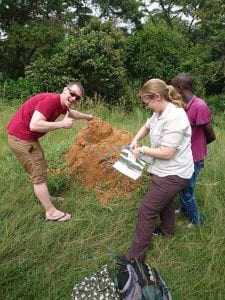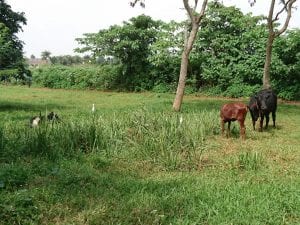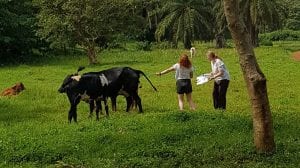Monday 21 January 2019

Taking an air sample beside a termite mound (Steve Andrews, Rebecca Fisher and our very understanding tour guide)
Today was another down day, with access to the aircraft for instrument scientists. We are fairly well prepared for the flights, as we originally wanted to start flying today, but hold-ups with permissions mean that we will be lucky to fly tomorrow. So we have got several flight plans fully prepared, and we are just keeping an eye on the weather forecasts and waiting for the all clear.
Instead of obsessing over the weather, some of us went to buy local SIM cards and have lunch. So far, so uneventful. We then decided to walk back to the hotel via the botanical gardens, and this is where the day turned up some unexpected excitement. Rebecca Fisher from Royal Holloway, a seasoned and clearly very dedicated field scientist, had come prepared with three air sampling bags and a pump. So when we saw termite mounds in the botanical gardens, Rebecca and I were grinning with glee, as termites are one of the more unusual sources of methane, and one which we hadn’t measured before! The down side of our enthusiasm was that the termites weren’t terribly pleased and one bit me. I admit that termites weren’t on the risk assessment as we had no idea we would see any.
After learning some more about indigenous and non-indigenous plants in the gardens, and spotting various birds (kingfisher, ibis, cormorant, egret and a few more unidentified ones) and a troop of monkeys, we found some cows hanging out with some egrets. And of course, took another sample, cows being a favourite methane source to measure.
One final sample on the beachfront later, and we were done with the sampling. Rebecca will analyse the air back in the UK to see how much carbon-12 and carbon-13 there is in the methane. Sampling close to a source (e.g. a termite mound) is a way to identify that source’s signature amount of carbon-13 relative to carbon-12. The better we know this from a range of different sources, the better we can work out the origin of a methane measurement far away from the source, by matching up this so-called isotopic fingerprint.
For more about this kind of isotopic fingerprinting, see this blog from our previous campaign about methane in the Arctic.

